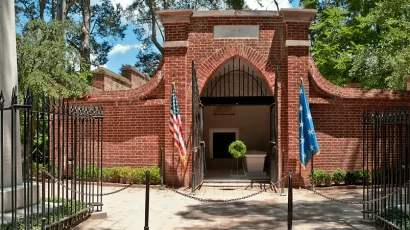George Washington was interred what is known as the “New Tomb” in 1831 alongside various members of the extended Washington and Custis family. Previously, members of the Washington family including Washington had been laid to rest at what is now referred to as the “Old Tomb.” Washington was placed in the “Old Tomb” three days after his death per his instructions on December 18, 1799.1 The “New Tomb” or “Tomb” is located west from the mansion, near the present-day Fruit Garden and Nursery, inland from the location of the “Old Tomb,” where Washington expressed interest in the construction of a new tomb.2

George Washington's will directed the building of the present vault in the following words: "The family Vault at Mount Vernon requiring repairs, and being improperly situated besides, I desire that a new one of Brick, and upon a larger Scale, may be built at the foot of what is commonly called the Vineyard Inclosure. . . In which my remains, with those of my deceased relatives (now in the old Vault) and such others of my family as may chuse to be entombed there, may be deposited."3 The construction of the “New Tomb” aligned with the desires of Washington. Members of the Washington and Custis families were interred or buried on the grounds of the “New Tomb” referred to as “East of the New Tomb” from 1832 to 1852.
Immediately after Washington's death, Congress resolved that a marble monument should be erected to his memory in the new Capitol in the city of Washington, desiring that his family would permit his body to be deposited beneath it. Martha Washington ensured Washington’s body remained in the family tomb.4 A crypt was provided under the dome of the Capitol, but the project was never completed.

In 1831, the surviving executors of Washington's estate removed the bodies of George and Martha Washington and those of other members of the family from the old vault to a similar structure within the present enclosure at Mount Vernon. Behind the iron gate are two marble sarcophagi, one inscribed "Washington," the other "Martha, Consort of Washington."
However, in 1832, when the nation observed the centennial of the birth of George Washington, the proposal for the removal of his body to the Capitol was revived. Congress authorized application to the proprietor of Mount Vernon, John A. Washington, for the transfer. However, the legislature of the Commonwealth of Virginia requested him not to consent. Washington elected to abide by his uncle’s wishes delineated in his will.
The marble sarcophagus that the body of General Washington now rests in was erected in 1837, which was the final update to the “New Tomb.” At that time the leaden inner casket was removed from the closed to the new marble vault and permanently entombed within it. A similar sarcophagus, more plainly sculptured, was provided for the remains of Martha Washington. The marble shafts in front of the Tomb were erected to the memory of Bushrod Washington and his nephew, John Augustine Washington, who in turn were proprietors of Mount Vernon. The former is buried in the inner vault while the latter is entombed in the Zion Episcopal Churchyard in Charles Town, West Virginia.
The "New Tomb" is recognized as a site to honor the life and legacy of George Washington by visitors and guests to Mount Vernon including politicians, popular figures, and representatives from other countries.
Updated by Zoie Horecny, Ph.D., 20 May 2025
Notes:
1. “II, 14 December 1799,” Founders Online, National Archives, in Tobias Lear’s Narrative Accounts of the Death of George Washington.
“George Washington’s Last Will and Testament, 9 July 1799,” Founders Online, National Archives.
“George Washington’s Last Will and Testament, 9 July 1799,” Founders Online, National Archives.
“From John Adams to Martha Dandridge Custis Washington, 27 December 1799,” Founders Online, National Archives.
Bibliography:
Costello, Matthew R. The Property of the Nation: George Washington’s Tomb, Mount Vernon, and the Memory of the First President. University, 2021.
Rasmussen, William S. and Robert S. Tilton. George Washington—The Man Behind the Myths. Charlottesville, VA: The University Press of Virginia, 1999.
Wineberger, James Albert. The Tomb of Washington at Mount Vernon. Washington, D.C.: T. McGill, 1857.

